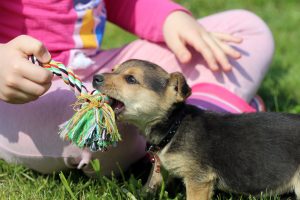By Sally Bradbury

A game of tug can help teach puppies when and how it is appropriate to use their teeth in play © Can Stock Photo / goce
If you’ve read the children’s book Jack and Billy: Puppy Tales that I co-wrote with Steven Goodall, you may remember that we related the tale of two littermates who were placed into two very different homes.
Explains Norris (2019): “In the case of Jack and Billy, both puppies go to homes that are similar: they both have children, both puppies have access to toys, both puppies are to be crate trained and house trained, and both puppies go out for walks. But there is a big difference in the two families’ approaches. While Jack’s family is organized in their puppy raising plan, it is easy to see that Billy’s family is not terribly prepared.”
While Billy’s family didn’t always get it right, it didn’t mean they loved him any less, not in the beginning anyway. For example, at bedtime they left him in the kitchen shut in a crate from day one. He cried at night for a long time because he was scared and alone. They taught him to urinate on newspaper in the kitchen but he was reprimanded for urinating in the kitchen if the newspaper wasn’t there. They gave him lots of toys and left them on the floor amid the children’s shoes and the TV remote and then got cross when Billy chewed the wrong thing.
They didn’t socialize him with other dogs which resulted in him being fearful and then reactive when he encountered dogs on walks. As a result of being reprimanded when out for walks, Billy did not always have such a great desire to be with his family and so when he was let off leash it was more fun to chase rabbits and squirrels. One day Billy discovered a meat bone in the kitchen garbage bin but not before he had scattered the rest of the contents all over the floor first. Billy often got himself into trouble just for being a puppy and was destined to fail simply because his family didn’t know how to help him succeed.
It’s actually quite straightforward to set your puppy up to succeed by just remembering these four points:
1. Prevent
2. Reinforce
3. Teach
4. Interrupt Positively
Prevent: Make sure your puppy doesn’t become distressed and scared at being alone by taking them to your room at night or by sleeping downstairs with them until pup is confident enough to be alone. During the day. Let puppy be with you in the early days if that’s what he chooses to do.
Put shoes in wardrobes when not on feet. Keep the TV remote out of reach. Use a puppy pen so that puppy is safely contained with his chew toys.
Reinforce: Capture behaviors that you like by giving praise and rewards when your puppy is engaging in desirable behaviors as this encourages pup to do it again at every opportunity.
Teach: Anything you’d like him to learn, e.g. outside is where you urinate; guardians are fun to be with on a walk, it’s a fun thing to stay on your bed and relax.
Interrupt: Teach a positive interrupter. Never get cross and risk frightening your puppy. Teach a word that means “Quick, stop what you are doing and get over here and see what I’ve got for you!” With the best will in the world no puppy goes through life never doing something we don’t want them to do!
Investment
Think of your relationship with you puppy as a bank account. Every positive interaction is a deposit and every time you scowl or get cross or punish you make a withdrawal. As soon as your account goes overdrawn then things will most likely go from bad to worse but keep a nice healthy bank balance and you and you pup will soon end up as millionaires in the relationship stakes.
Puppy Training Tip #1: Teach Your Puppy to Lie Down on Cue Using Capturing

Guardians can use capturing to train their puppy to lie down on cue © Can Stock Photo / fotojagodka
- Take your dog to the smallest room in the house. Take with you a pot of tasty treats cut up small, a good book and a coffee or preferred drink.
- Close the door and sit on the seat that is conveniently provided in there.
- Have a treat concealed in your hand.
- Read your book but keep one eye on puppy. When she lays down toss her a treat so she has to get up to get it. Go back to your book and wait for her to lay down again and repeat. Say nothing except for a quiet ‘goood’ as she lays down.
- When she knows that lying down gets her a treat, and you’ll know when she knows then add the word that you are going to use. You say “down.” She lays down and gets a treat.
- Now try it in other places but start back at the beginning again, no cue yet. She’ll get it even quicker the next time.
Puppy Training Tip #2: Introducing Your Puppy to a Harness
It’s worth taking time to make sure that having a collar and/or harness put on and wearing it and having it taken off is a positive experience for your puppy. Be prepared to stop at any time if he is uncomfortable and backs away at any point.
Once your puppy is happy to be touched anywhere then to introduce the harness have it next to you on the floor whilst feeding him. If you use a clicker then you can click and treat puppy for looking at or sniffing the harness. Or you can use a marker word such as ‘yes’ instead of a clicker.
Once puppy is happily touching the harness on the floor then hold it and have him touch it for a click and treat. The next stage might be to have him take the food from your hand that is through the harness with a view to him starting to put his head through to take the food from your hand. Then pop it over his head. Click and treat. Take it off. Click and treat. Make sure he is happy about the fasteners clicking before doing them up on him. You could even use the fastener as a clicker. Some puppies will sail through the whole process, others will need it broken up into lots of tiny steps.
I prefer a harness with a Y-shaped chest piece for comfort. Fleece ones for extra comfort. Avoid using anything that tightens and causes discomfort. Harnesses with a horizontal chest strap interfere with shoulder movement and should be avoided, in my opinion.
Puppy Training Tip #3: Games to Play with Your Puppy

Guardians can avoid potential pitfalls by setting up their puppies for success right from the outset © Can Stock Photo / schorsch
Tug
Play gentle games of tug with your puppy. Use a long soft toy, rope or fleece is ideal. Animate the toy on the floor and encourage puppy to grab it. You just need to hold it and be part of the fun. There is no need to pull or shake the toy, let puppy do that. Playing tug has many advantages, not least in giving him an outlet for his play biting. By putting it on cue you can teach a puppy what to bite and when to bite. Much better than trying to insist on no biting at all during play. After all that’s how puppies play. They have no hands.
Fetch
Gently roll a soft ball or toy across the ground and encourage puppy to chase and pick it up and bring it back.
There are a hundred and one uses for a dog that retrieves. Perhaps the biggest advantage is that you can completely avoid triggering the guarding behavior that is often associated with having to take an item from him that he has picked up that you would prefer him not to have. Using praise and encouragement, just as you would with his toy, will see him willingly bringing the forbidden item to you.
Find It
Let puppy watch you hide a toy and then encourage him to find it. Progress onto hiding it unseen and let puppy do what comes naturally and use his nose to search. Every family needs a dog that can find the keys.
Resources
Norris, B. (2019, September). A Tale of Two Puppies. BARKS from the Guild (38) 56-57. Available at: bit.ly/36VTyCf
This article was first published in BARKS from the Guild, July 2020, pp.38-39. For more great content on all things animal behavior and training, you can sign up for a lifetime, free of charge, subscription to the digital edition of BARKS from the Guild. If you are already a subscriber, you can view the issue here.
About the Author
Sally Bradbury has worked with dogs all her adult life, from RSPCA kennel maid in her teens to founding and running her own very successful dog training business for 20 years. She was also a founding member of the APDT (United Kingdom). Her passion is helping and supporting new puppy owners raise their puppies to avoid the many pitfalls that result in so many youngsters being handed into rescues in their first year. She is now retired and living in Wales and has recently published the children’s book, Jack and Billy: Puppy Tales, featuring two puppies who experience vastly different journeys in their new homes.
